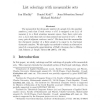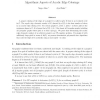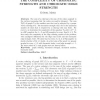617 search results - page 18 / 124 » On the Chromatic Number of Random Graphs |
DAM
2010
13 years 7 months ago
2010
In the minimum sum edge coloring problem, we aim to assign natural numbers to edges of a graph, so that adjacent edges receive different numbers, and the sum of the numbers assign...
JGT
2008
13 years 7 months ago
2008
The measurable list chromatic number of a graph G is the smallest number such that if each vertex v of G is assigned a set L(v) of measure in a fixed atomless measure space, the...
ALGORITHMICA
2002
13 years 7 months ago
2002
A proper coloring of the edges of a graph G is called acyclic if there is no 2-colored cycle in G. The acyclic edge chromatic number of G, denoted by a (G), is the least number of...
ENDM
2007
13 years 7 months ago
2007
d Abstract) Pascal Ochem∗, Alexandre Pinlou† LaBRI, Université Bordeaux 1, 351, Cours de la Libération, 33405 Talence Cedex, France March 16, 2007 A homomorphism from an ori...
CC
2006
Springer
13 years 7 months ago
2006
Springer
The sum of a coloring is the sum of the colors assigned to the vertices (assuming that the colors are positive integers). The sum (G) of graph G is the smallest sum that can be ach...



